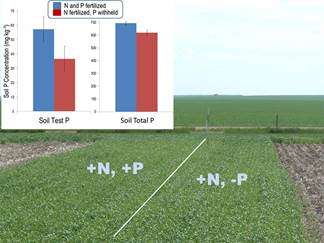Bringing high tech to soil research

2015 is the International Year of the Soils. Healthy soils are vital to sustainable food systems, clean lakes, verdant forests, and the health of our planet. In honour of the occasion, we offer you a profile of a scientist committed to studying the key elements in our soils.
"The concept that not all fertilizer is used by each plant has been known for decades," Barbara Cade-Menun, a researcher for Agriculture and Agri-Food Canada (AAFC), explained. "It's something that we know is there and most people assume some of that will be available when they do their fertilizer assessments."
While most farmers take into account previous rounds of fertilizer to plan their crop care, the estimates of key element levels, like phosphorus and nitrogen, are full of unknowns.
Cade-Menun focuses on the questions surrounding phosphorus left over from fertilizers. For example, one hot topic is how phosphorus moves through the soil, and how much is washed away into lakes, where the nutrient can trigger massive algae blooms.
Another, even more challenging question: what does the leftover phosphorus in the soil looks like? Is it inorganic, bonded to other metals in forms plants can use, or is it mostly organic, which microbes must break down to plant-available forms? And what sources of phosphorus do plants actually rely on?
Answering these questions could help industry develop better fertilizers, honed so that specific crops could use up the nutrients entirely, thereby reducing the risk of phosphorus run-off damaging lakes.
Cade-Menun's team has a set of resources and skills that makes them uniquely capable to explore these big agricultural questions.
First, there's Cade-Menun herself, an expert in phosphorus chemistry and in the nuclear magnetic resonance (NMR) techniques required to study organic phosphorus in soils and other materials.
Then there's the U of S campus, which houses not only the Saskatchewan Structural Sciences Centre (SSSC), which houses the NMR instruments necessary to study organic phosphorus, but also the Canadian Light Source Synchrotron (CLS), which enables the team to study key inorganic phosphates in unprecedented detail.
The last piece in the puzzle is the long-term crop rotations maintained by AAFC at Research Centres across Canada. For this study, Cade-Menun used wheat plots at the Semiarid Prairie Agricultural Research Centre (SPARC) in Swift Current, SK, where she is based. From 1967 to 1995 these plots (three for each crop rotation) received identical phosphorus and nitrogen fertilizer treatments. In 1995, each plot was divided into two, and phosphorus fertilization stopped on one half, continuing as usual on the other half (nitrogen fertilization continued on both halves). Soil samples going back to 1995 trace the soil's history on each plot, providing an incredible long-term research resource.
"It's really not until you start putting all of that together (AAFC staff and plots, CLS, SSSC) at that level that you can have these opportunities to see things that 10 years ago we couldn't have even dreamed of understanding," says Cade-Menun.
Oddly enough, 15 years after half the wheat plots stopped receiving phosphorus fertilizer, nothing has changed with respect to crop yield. Both parts of the plots continue to produce equally, despite drastically different nutrient additions.
By combining CLS techniques with NMR, the team put together a picture of how the unfertilized soil changed over time as compared to its fertilized counterpart, to understand how wheat plants coped with the change.
Sure enough, the plants on phosphorus fertilizer-free plots had significantly drawn down the levels of easily-accessible phosphorus in the soil, "Which would tell us we should put fertilizer on there, except that the yields haven't changed," said Cade-Menun.
This unexpected result means that producers might be able to change the way they use fertilizers, to better reflect the resilience of phosphorus sources in the soil. The work could also be used to improve prairies wheat fertilizers. Meanwhile, the team is continuing their study to see what happens to plants once they completely deplete their inorganic phosphorus sources.
They're also interested in developing CLS techniques alongside NMR to look at water samples and how microbes access phosphorus. Using synchrotrons for soil research is still a relatively new phenomenon, as researchers develop new ways to improve crop yields and protect ecosystems.
More information: Liu, Jin, et al. "Investigation of Soil Legacy Phosphorus Transformation in Long-term Agricultural Fields Using Sequential Fractionation, P K-edge XANES and Solution P-NMR Spectroscopy." Environmental science & technology(2015). DOI: 10.1021/es504420n
Journal information: Environmental Science & Technology
Provided by Canadian Light Source
















